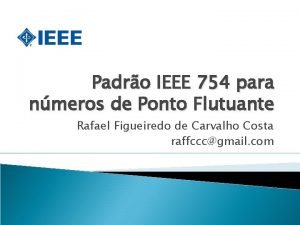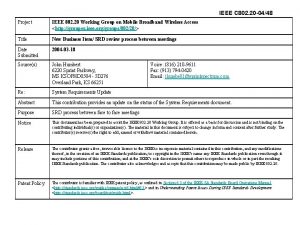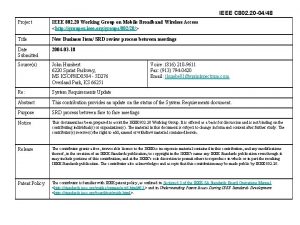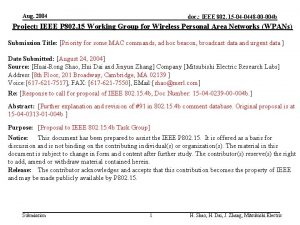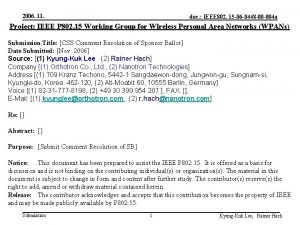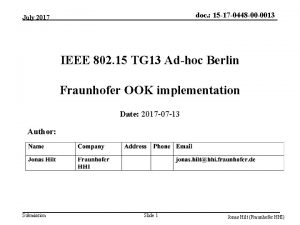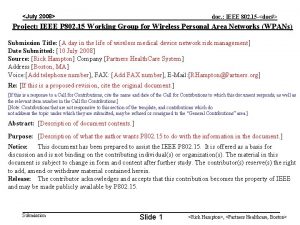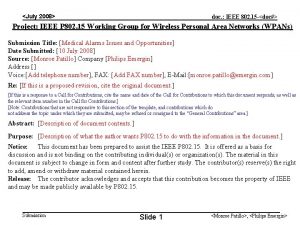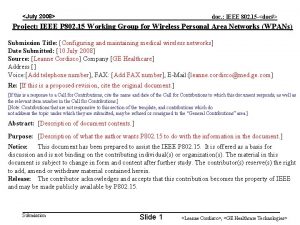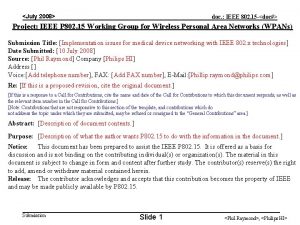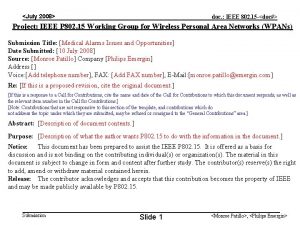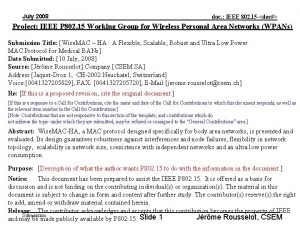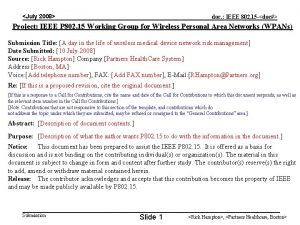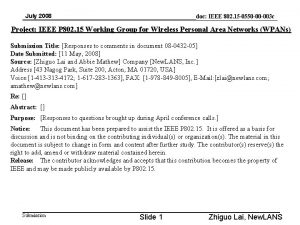July 2008 doc IEEE 802 15 08 0448



















- Slides: 19

July, 2008 doc. : IEEE 802. 15 -08 -0448 -00 -0006 Project: IEEE P 802. 15 Working Group for Wireless Personal Area Networks (WPANs) Submission Title: [Self-Organizing MAC Issues for BAN] Date Submitted: [14 th July, 2008] Source: [Seung-Hoon Park / Ranjeet Kumar Patro / Noh-Gyoung Kang / Chihong Cho / Eun-Tae Won] Company [Samsung Electronics Co. Ltd. ] Address [416, Maetan-3 dong, Yeongtong-gu, Suwon-si, Gyeonggi-do, 443 -742, Korea] Voice: [+82 -31 -279 -4579], FAX: [+82 -31 -279 -5130], E-Mail: [shannon. park@samsung. com] Re: [] Abstract: [This document describes the necessity of self-organizing concept for BAN system] Purpose: [To promote discussion within the BAN group of the necessity of self-organizing MAC] Notice: This document has been prepared to assist the IEEE P 802. 15. It is offered as a basis for discussion and is not binding on the contributing individual(s) or organization(s). The material in this document is subject to change in form and content after further study. The contributor(s) reserve(s) the right to add, amend or withdraw material contained herein. Release: The contributor acknowledges and accepts that this contribution becomes the property of IEEE and may be made publicly available by P 802. 15. Submission 1 Seung-Hoon Park et al. , Samsung

July, 2008 doc. : IEEE 802. 15 -08 -0448 -00 -0006 Self-Organizing MAC Issues for BAN “Global order can arise from local interactions” <Alan Turing> Submission 2 Seung-Hoon Park et al. , Samsung

July, 2008 doc. : IEEE 802. 15 -08 -0448 -00 -0006 What is Self-Organization? • Each individual entity is organized without any external or central dedicated control entity • Through local interactions & simple rule, emergent behavior (structure or pattern) is emerged Submission 3 Seung-Hoon Park et al. , Samsung

July, 2008 doc. : IEEE 802. 15 -08 -0448 -00 -0006 Properties of Self-Organized System Property Description No central control There is no global control system or global information available. Each subsystem must perform completely autonomous, adapting to changing conditions Emerging structures The global behavior or functioning of the system emerges in form of observable pattern or structures. Resulting complexity Even if the individual subsystems can be simple as well as their basic rules, the resulting overall system becomes complex, hierarchical and often unpredictable. High scalability There is no performance degradation if more subsystems are added to the system. The system should perform as requested regardless of the number of subsystems. Submission 4 Seung-Hoon Park et al. , Samsung

July, 2008 doc. : IEEE 802. 15 -08 -0448 -00 -0006 Self-Organization Example : Time Synchronization of Fire-flies • Modeling one fire-fly – Integrate-and-fire oscillator • Modeling two fire-flies – Coupled integrate-and-fire oscillator – Firing of one oscillator causes other oscillator to increment phase – Submission 5 Seung-Hoon Park et al. , Samsung

July, 2008 doc. : IEEE 802. 15 -08 -0448 -00 -0006 Protocols of BAN • BAN requirements – Energy efficiency from minimizing collisions, overhearing, Idle listening, or protocol overhead – Low complexity for limited sensor capability • Considerable protocols to meet BAN requirements – – • Channel access Topology Routing Time synchronization Dense condition of nodes on and around the body – Topology does not change frequently – 1 -hop transmission in most cases – Time synchronization is easier than sparse condition • Channel access is most considerable challenge for BAN performance Submission 6 Seung-Hoon Park et al. , Samsung

July, 2008 doc. : IEEE 802. 15 -08 -0448 -00 -0006 Contention-based Channel Access • Random access • Pros – resource reservation is not preceded – high scalability, high adaptability • Cons – channel monitoring in idle mode high energy consumption – contention for the channel long delay – scheduling to reduce collision control overhead – Qo. S is not guaranteed Submission 7 Seung-Hoon Park et al. , Samsung

July, 2008 doc. : IEEE 802. 15 -08 -0448 -00 -0006 Contention-free Channel Access • Scheduled access • Pros – Low energy consumption – Low delay & guaranteed Qo. S • Cons – – Pre-defined resource slot low assignment flexibility Low scalability hierarchical structure is required Time synchronization is required Centralized scheduling • channel state information & channel assignment overhead • peer-to-peer direct communication is impossible • lack of flexibility when the amount or the period of traffic generated by a node vary with time Submission 8 Seung-Hoon Park et al. , Samsung

July, 2008 doc. : IEEE 802. 15 -08 -0448 -00 -0006 Hybrid Channel Access • Tradeoff & mix-up between contention based and contentionfree channel access • Pros – Adaptability to the changing & heterogeneous traffic load • Cons – Too much control overhead & high system complexity to provide hybrid benefits – Support for real-time VBR traffic is not easy • Centralized control is not sufficient to dynamic change of system condition • Can distributed control solve this problem? Submission 9 Seung-Hoon Park et al. , Samsung

July, 2008 doc. : IEEE 802. 15 -08 -0448 -00 -0006 Centralized System permanent control (fixed hierarchies) C S 1 Submission S 2 S 3 10 S 4 Seung-Hoon Park et al. , Samsung

July, 2008 doc. : IEEE 802. 15 -08 -0448 -00 -0006 Distributed System temporary control (dynamic organization) C S 2 System A S 1 System B System C Application S 4 Distributed control, i. e. middleware architecture S 3 Local system control (HW, OS) Communication network Submission 11 Seung-Hoon Park et al. , Samsung

July, 2008 doc. : IEEE 802. 15 -08 -0448 -00 -0006 Self-Organized System C Local system control C S 2 C S 3 C Submission C S 1 Local interactions (environment, neighborhood) S 4 Simple local behavior S 5 C 12 S 6 Seung-Hoon Park et al. , Samsung

July, 2008 doc. : IEEE 802. 15 -08 -0448 -00 -0006 System Comparison by Control Type Centralized Pros Cons Submission Distributed Self-organized • Simple • Effectiveness • Easy resource access at subsystem • Transparency • Scalability • Adaptability • Fault tolerance (by redundancy) • Fast adaptability • Robustness (insensitive to subsystem failure) • High scalability • Complexity from simple rule • No global state maintenance • Low scalability • Low flexibility on dynamic condition • Difficult synchronization • Overhead of resource management • Too much of network bandwidth for control • Local optima • Non-linearity & unpredictable property • Cross-mechanism interference 13 Seung-Hoon Park et al. , Samsung

July, 2008 doc. : IEEE 802. 15 -08 -0448 -00 -0006 Basic Methods in Self-Organized System • Positive and negative feedback – Positive feedback: amplification, accelerated system response – Negative feedback: suppression, stabilization • Interactions among individuals and with the environment – Direct communication among neighboring systems – Indirect communication via the environment – Interaction with the environment • Probabilistic techniques – leaving local optima – adaptability to dynamics Submission 14 Seung-Hoon Park et al. , Samsung

July, 2008 doc. : IEEE 802. 15 -08 -0448 -00 -0006 Self-Organizing Channel Access • Positive and negative feedback – Control the medium access (timing, number of slots, power, etc) – Control protocol or control parameters • Interactions among individuals and with the environment – Direct: intensive protocol inherent interactions between neighboring nodes to detect, avoid or prevent collisions – Indirect: information exchange using signal strength measurements – Emergent functionality (time synchronization or channel assignment, etc) based on exchanged information or interacting protocol messages • Probabilistic techniques – Reduced collision probability through randomized medium access – Fairness and mutual exclusion Submission 15 Seung-Hoon Park et al. , Samsung

July, 2008 doc. : IEEE 802. 15 -08 -0448 -00 -0006 Self-Organizing Channel Access • Potential goals – – – Low power consumption Low control overhead Improve fairness, delay, bandwidth High resource efficiency Reduce collision, idle listening, overhearing • at high traffic load or high node density condition – Adaptability to heterogeneous traffic • Technical challenges – Minimize unpredictable behavior – Preserve simplicity supporting complex management Submission 16 Seung-Hoon Park et al. , Samsung

July, 2008 doc. : IEEE 802. 15 -08 -0448 -00 -0006 Self-Organizing Channel Access • Referential MAC algorithms – Sensor MAC • supports multiple schedules and long sleep cycles with adaptive listening – Power Control MAC • well-controlled transmission power, can be combined with any RTS/CTS based MAC protocol – Wi. Media MAC • distributed MAC using DRP (Distributed Reservation Protocol) and PCA (Prioritized Channel Access) Submission 17 Seung-Hoon Park et al. , Samsung

July, 2008 doc. : IEEE 802. 15 -08 -0448 -00 -0006 Conclusion • BAN MAC has unique requirement – – – Energy efficiency Scalability Qo. S Reliability Robustness Lightweight system • Self-Organization techniques are needed to meet these requirement in the resourcelimited sensor condition Submission 18 Seung-Hoon Park et al. , Samsung

July, 2008 doc. : IEEE 802. 15 -08 -0448 -00 -0006 References • • [1] “Self-Organization in Sensor and Actor Networks”, Falko Dressler, WILEY; ISBN: 978 -0 -470 -02820 -9; Hardcover; 386 pages; January 2008 [2] “Self-organization in communication networks: principles and design paradigms”, Prehofer, C. ; Bettstetter, C. ; Communications Magazine, IEEE, Volume 43, Issue 7 , July 2005 Page(s): 78 – 85, Digital Object Identifier 10. 1109/MCOM. 2005. 1470824 [3] “Self-organisation in future mobile communications”, Spilling, A. G. ; Nix, A. R. ; Beach, M. A. ; Harrold, T. J. ; Electronics & Communication Engineering Journal, Volume 12, Issue 3 , June 2000 Page(s): 133 - 147 [4] IEEE 802. 15 -08 -0053 -01 -0006, “The MAC Protocol Requirements for BAN”, Maulin Patel, Philips [5] IEEE 802. 15 -08 -0305 -00 -0006, “MAC considerations of Non-medical Application for the BAN”, Sung. Hyup Lee, KORPA [6] IEEE 802. 15 -08 -0331 -01 -0006, “Literature Review of Energy Efficient MAC in WSN/BAN”, Hind Chebbo, Fujitsu [7] IEEE 802. 15 -08 -0334 -02 -0006, “A Perspective of the BAN MAC”, Okundu Omeni, Toumaz Technology Ltd Submission 19 Seung-Hoon Park et al. , Samsung
 Bridges from 802.x to 802.y
Bridges from 802.x to 802.y Bridges from 802.x to 802.y
Bridges from 802.x to 802.y Ieee 802 3 compliance
Ieee 802 3 compliance Ieee 802
Ieee 802 Arquitetura ieee 802
Arquitetura ieee 802 Estandares ieee 802
Estandares ieee 802 Ieee 802 standard
Ieee 802 standard 802 15
802 15 802 ieee
802 ieee Ieee 802
Ieee 802 Ieee 802 family
Ieee 802 family 2008 2008
2008 2008 Ieee standard 829
Ieee standard 829 Ieee 754-2008
Ieee 754-2008 Gdje se rodio nikola tesla
Gdje se rodio nikola tesla 2003 july 17
2003 july 17 Catawba indian nation bingo
Catawba indian nation bingo On july 18 2001 a train carrying hazardous chemicals
On july 18 2001 a train carrying hazardous chemicals Sylvia plath poppies in july
Sylvia plath poppies in july Gcc july 2020
Gcc july 2020













